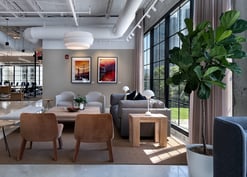 Transforming an unfurnished commercial space into a welcoming and comfortable work environment on time and on budget requires professional expertise. For many companies, the first (and sometimes only) step taken in achieving this goal is the hiring of a commercial interior designer.
Transforming an unfurnished commercial space into a welcoming and comfortable work environment on time and on budget requires professional expertise. For many companies, the first (and sometimes only) step taken in achieving this goal is the hiring of a commercial interior designer.
Due to the broad and involved nature of the designer’s role, they must place their primary concerns on utility. The bare necessities and functional fixtures—such as furniture, paint, flooring, white boards, and TVs—dominate the budget and, as a result, the designer’s focus. Office artwork, the heart and soul of any space and the finishing touch to any good design, is too often an afterthought.
To avoid the risk associated with tailoring an art program to a specific space, budget, and theme independently, commercial designers often turn to third-party resources for wall decor.
For projects under time or budget constraints, designers frequently default to big-box art sources for inexpensive, open edition prints to meet their project goals. Although these superstores supply a quick fix, the resulting presentation can feel as uninspired as the source--serving only to accent a project’s agreed-upon aesthetic as it relates to fundamental concepts of balance, color, form, line, and utility.
Commercial designers that are given the financial resources to invest in an art program for their clients will turn to galleries for high-end giclée prints and original works. Invariably, however, these galleries are forced to operate with smaller inventories due to space constraints. So while they offer the quality chain suppliers lack, the options they provide are often too narrow to effectively capture the nuances of an individual company's brand, team, and culture. Moreover, the artist’s earning percentage from a final sale price shrinks as the the client incurs both the gallery and designer commissions.
Companies actively seeking a purposeful art program to augment their designer’s vision can turn to freelance art consultants or firms. Most consultants have art or design backgrounds, understand the market well, and can bring meaningful industry insights to a collection where a designer may fall short. However, a high-touch, proficient consultant comes with a hefty price tag. As a result, a client’s budget determines the quality of consulting and artwork provided. Freelancers and firms alike must evaluate the costs of providing their full suite of services, from the early stages of curation to the final stages of installation, in relation to the value of the artwork purchased. If a day of consulting costs the client more than the actual piece of artwork, the value of their service may be subject to question. To prevent discrepancies, consultants seek deep-pocketed clients and big-name galleries to build high-end collections backed by industry reputations and hardened investment strategies. While consulting services have successfully provided traditional solutions to specific artwork needs for many years, their model neglects to meet the changing and diverse needs of most businesses today.
Regardless of whether a company leaves art selections to their designer or hires their own consultant, they must choose between saving money or getting high-quality artwork. Despite technology changing the way we access and interact with art on an individual basis, the commercial art industry has resigned to a collective “if it ain’t broke don’t fix it” mentality, leaving today’s companies with yesterday’s solutions.
TurningArt is designed to fill in industry gaps with access to dynamic and affordable artwork through a convenient subscription program. The flexibility and quick turnaround time of big-box stores is afforded through our print leasing service, but instead of sending the millionth edition of a generic stock print, we make our selections from the portfolios of over 1,000 independent artists with whom we’ve established direct relationships.
As an Art Advisor, my goal is to build collections that reflect the unique experience each client wants to have in their space—and just in case that notion sounds idealized, I want to mention that, inspired by an office inside joke, we recently installed a piece titled “Unicorn Burger” at a client's headquarters.
With commercial lease turnovers occurring, on average, every 5 years, investing tens of thousands of dollars in artwork for a specific space is an unnecessary and even risky expense. To avoid placing heavy bets on pieces or styles that might not stand the test of time, TurningArt leases artwork to grant companies access to artwork, but through a low-risk and flexible format. With rotating art options, we refresh each of our client’s collections on fixed basis to avoid outdated trends that leave their space feeling stale.
To meet the needs of all kinds of budgets, clients can build their collections in prints, original works, or a mixture of both. In both leases and outright sales, TurningArt offers affordable standardized pricing for prints and a wide range of pricing for originals. No matter what a space needs, the diverse and flexible nature of our products and service has the solution.
Today’s commercial client should not be asking themselves polarized questions like “rent or buy?”, “prints or originals?”, “quality or cost?” when, instead, they should be asking “why choose?”.
.jpg?width=332&height=177&name=_MG_0840%20copy%20(2).jpg)

.jpg?width=332&height=177&name=dtBv_067_DSC_2139_DaNil%20(2).jpg)

.jpg?width=332&height=177&name=TurningArt_EnerNoc_2-18-2014-3_Final%20(1).jpg)

